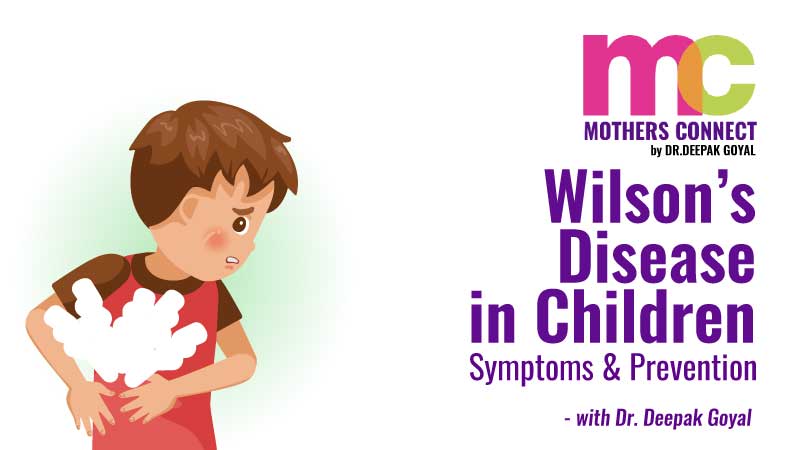
WHAT IS WILSON’S DISEASE?
Wilson’s Disease is a rare inherited disorder that results in the accumulation of copper the liver, brain and other vital organs
Copper plays an extremely important role in the development of healthy nerves, bones, collagen (the most abundant protein that plays a crucial role in holding the body’s cells together), and skin pigment melanin. In a normal, healthy body, copper is absorbed from the food we eat and the excess copper is excreted through bile produced in the liver.
When a child has Wilson’s Disease, the liver is unable to excrete copper and the excessive build-up of copper in the liver causes progressive damage. The excess copper eventually gets into the bloodstream and forms deposits in the brain, kidneys and eyes. This leads to severe complications, such as liver failure, kidney damage and nerve damage, and could also be life-threatening.
WHAT ARE THE SYMPTOMS OF WILSON’S DISEASE?
Since Wilson’s Disease is an inherited disorder, it is present when a child is born, but the signs and symptoms do not appear until the excessive build-up of copper in the brain, liver or other organs. Symptoms usually start when the child turns five years and they vary from child to child depending on which organs are most affected.
The various symptoms of Wilson’s Disease are:
- Weakness and unusual fatigue
- Weight loss because of lack of appetite
- Stomach pain or bloating
- Swelling the legs, ankles or the feet
- Easy bruising or bleeding
- Jaundice
- Muscle cramps
- Formation Kayser-Fleischer Rings – brown rings in the outer part of the eye
In some cases, the disease begins to affect the body’s nervous system and a child would the following symptoms:
- Difficulty in walking
- Problems with speech and language
- Changes in behavior
- Problems with motor skills, such as writing, talking, balancing
- Tremors
WHAT CAUSES WILSON’S DISEASE?
Children inherit Wilson’s Disease from their parents.
If both the parents have the gene mutation for Wilson’s Disease, the probability of their children developing the disease is 25%; and if only one parent carries the mutation, their children will not develop the disease, but they might carry the gene mutation which they could pass to their children.
WHAT ARE THE POSSIBLE COMPLICATIONS OF WILSON’S DISEASE?
If left untreated, Wilson’s Disease can prove to be fatal. The various severe complications include the following:
- SCARRING OF THE LIVER (CIRRHOSIS) – The liver cells try to make repairs to the damage caused by excess copper, however, during that process scar tissue forms in the liver hampering the liver function.
- LIVER FAILURE – With WIson’s Disease, acute liver failure is a strong possibility and a liver transplant might be the only treatment option.
- KIDNEY PROBLEMS – Wilson’s Disease can lead to kidney damage and could lead to problems such as kidney stones and excretion of an abnormal number of amino acids in the urine.
- PSYCHOLOGICAL PROBLEMS – The disease could also lead to some serious psychological issues, such as change in personality, depression, irritability, bipolar disorder or psychosis.
- BLOOD PROBLEMS – Destruction of red blood cells is also a possibility and it could lead to anemia and jaundice.
HOW IS WILSON’S DISEASE DIAGNOSED?
Unfortunately, diagnosing Wilson’s Disease is a challenge as the symptoms resemble those of many other liver diseases such as hepatitis. Further, the symptoms can evolve over time and the behavioural changes that happen are hard to link to Wilson’s Disease.
To check for Wilson’s Disease, your child’s pediatrician will start with an understanding of the child’s medical history and also ask questions about unexplained weight loss, vomiting, fatigue and other symptoms. The pediatrician will also check the child’s family history to determine if any other members of the family have Wilson’s Disease. A physical exam would also be done to check for signs of anemia, swelling in the feet or legs, abdominal bloating. An eye exam would be done to look for Kayser-Fleischer rings.
The pediatrician would then do the following tests to confirm:
- A liver biopsy to determine the amount of copper in the liver.
- Urine test to look for levels of copper in the urine.
- A blood test to check for low levels of copper protein (ceruloplasmin) in the blood.
- Genetic testing to detect the gene mutation for Wilson’s Disease.
HOW IS WILSON’S DISEASE TREATED?
The objective of treatment for Wilson’s Disease is to help the liver excrete copper and prevent it from accumulating again. Ooral medications called chelating agents are given. These medications/ chelating agents prompt the organs to release the copper into the bloodstream which is then filtered by the kidneys and released through the urine.
Children suffering from Wilson’s Disease would need to take these oral medications several times a day for the rest of their lives.
The pediatrician would also recommend avoiding certain foods that are high in copper, such as mushrooms, nuts, chocolates, dried fruit, liver and shellfish.
If the liver damage is severe, the pediatrician would refer your child to a pediatric hepatologist who might recommend a liver transplant.
WHAT SHOULD YOU, AS A MOTHER DO, IF YOUR CHILD IS DIAGNOSED WITH WILSON’S DISEASE?
Based on your consultation with your child’s pediatrician, you would need to limit the amount of copper your child consumes in his/ her diet and avoid foods with high copper content, such as liver, shellfish, mushrooms, nuts and chocolates.
You should also get your tap water’s copper levels tested and also avoid multivitamins that contain copper.
WHAT IS THE LONG-TERM OUTLOOK FOR CHILDREN DIAGNOSED WITH WILSON’S DISEASE?
It is crucial to diagnose and treat Wilson’s Disease as early as possible because the symptoms of the disease are progressive and if left untreated may cause damage that is irreversible. Fortunately, with proper diagnosis and treatment, the progression of Wilson’s Disease can be stopped and symptoms may improve.

